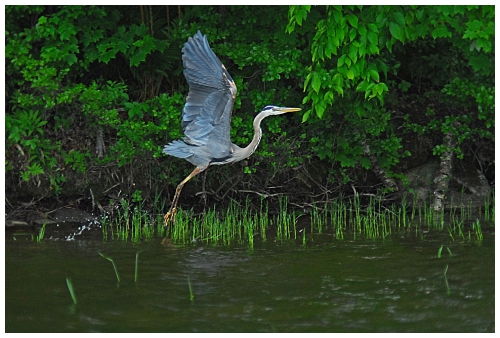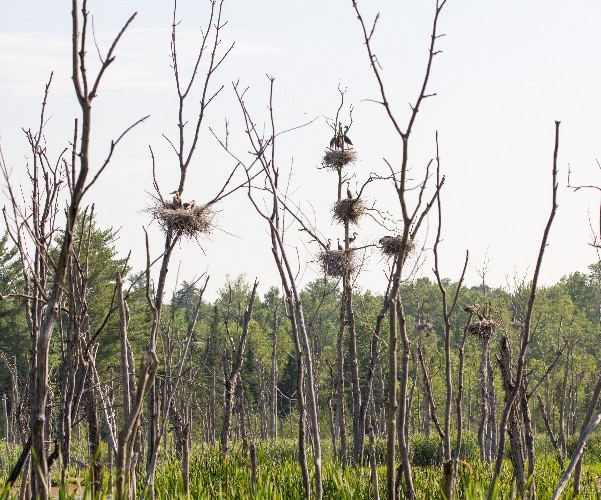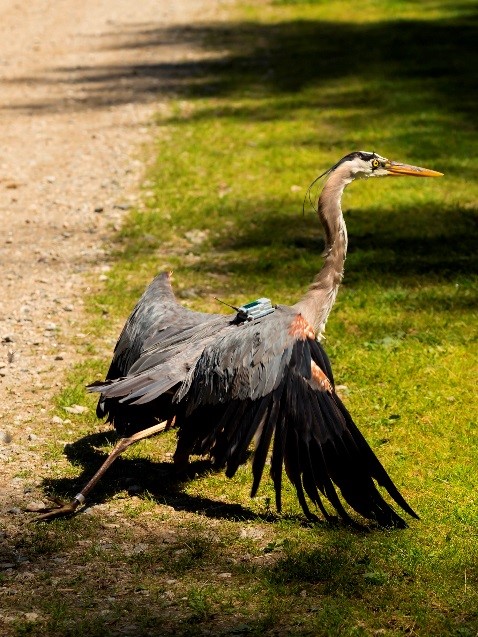December 4, 2019 at 2:37 pm
Three years ago, MDIFW embarked on a heron tracking project, which has since redefined how many Mainers view great blue herons, understand their habitats and movements within the state as well as beyond our nation’s borders. Prior to this project, we knew little about where herons wintered, how many years they may nest in the same colony, how far they fly to forage. Additionally, we knew little about nesting, post-breeding, migration and wintering seasons.

Great blue herons’ nest in groups, or colonies, which may contain a few pairs to several hundred, often with multiple nests occupying the same tree. Herons occupy vital aquatic habitats where they provide balance to the ecosystem as a predator, feeding near the top of the food chain, controlling a wide variety of fish, aquatic invertebrates and insect populations. Herons are also relatively long-lived, making them good indicators of environmental quality, including wetland health, levels of toxic substances, and levels of human disturbance.

The great blue heron has recently experienced a decline in its population in Maine and is listed as a state Species of Special Concern. They nest in every county in Maine, but the coastal island breeding population has experienced a steady downward trend from 1,203 pairs in 1983 to just 211 pairs in 2018. The inland breeding population also shows evidence of decline, but its extent is unknown. Volunteers with the Heron Observation Network have been monitoring colonies through the adopt-a-colony program for 11 years to better understand the statewide trend.
In 2016, when we tagged the initial five great blue herons with solar-powered GPS transmitters, our main goals were to learn more about heron habits and movement, discover potential limiting factors for nesting herons in Maine, and connect students of all ages to the outdoors through these great winged ambassadors. By working with local schools, we immersed students in field work to catch bait fish for luring herons to a capture location. Some students even had the opportunity to witness biologists tag and measure the herons that they eventually followed online in their classrooms. To date, we have worked with 10 elementary or high school level programs, students at Unity College and the University of Maine, and we have even established connections with a teacher in Haiti who is getting her students interested in birds.

This project is ongoing as long as our transmitters continue to recharge with the sun and provides GPS locations showing the whereabouts of our tagged great blue herons. Even after transmitters log their last locations, all the data collected will continue to be available for anyone to view and investigate online through the open-source website. To date, we have obtained migration data from six individual great blue herons, revealing wintering areas in Florida, Cuba, The Bahamas, and Haiti. We have seen four of our herons’ nest consistently in the same colony, one switch colonies the second year, and one decide not to breed and head further to North Brunswick. By looking at movement data, we can pick out important foraging areas and determine the habitats that are most important to each individual, how much area they need, and how far they are willing to fly to feed. Our most recent discovery was witnessing “Harper” migrate across the open ocean for 38 hours nonstop from St. John, New Brunswick to Nocatee, Florida.
Tracking projects are expensive and require continuous funding to cover costs of GPA trackers. This is where Maine Birder Band comes in. For years, birder bands have helped biologists understand migratory population trends and habitat needs of various bird species, now, the Maine Birder Band is available as a tool to support our non-game and endangered species conservation efforts by directly funding projects like the Heron Tracking Project when purchased. Combined with a grant from the Maine Outdoor Heritage Fund, a small amount from the State of Maine General Fund, and the value of volunteers’ participation, along with the matched federal funding leveraged by the Maine Birder Band sales, it has helped contribute over $44,000 towards this project! Maine Birder Bands can proudly be worn on your binocular or camera strap, and each band contains a number that is registered to the buyer at the time of purchase to aid in reporting lost and recovered optics.
To learn more about the Heron Tracking Project, including instructions on how to view and download the tagged herons’ data, visit MDIFW’s online tracking instructions.
To support this project and other important bird conservation work in Maine, consider purchasing a Maine Birder Band from our online store as a holiday gift for the birder in your life!